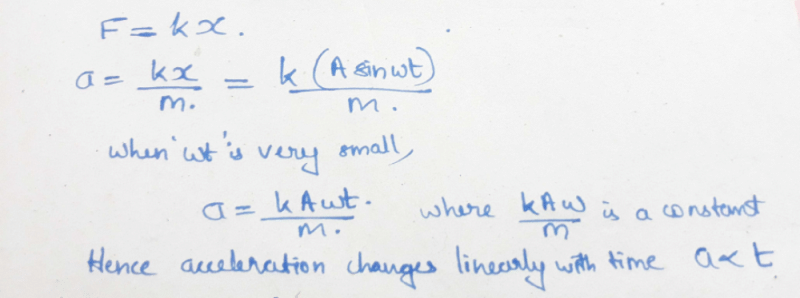NEET Exam > NEET Questions > If a particle is executing simple harmonic mo...
Start Learning for Free
If a particle is executing simple harmonic motion then acceleration of particle 1) is uniform 2) varies linearly with time 3) is non uniform 4) both 2 and 3?
Most Upvoted Answer
If a particle is executing simple harmonic motion then acceleration of...
Understanding the Acceleration of a Particle in Simple Harmonic Motion
Definition of Simple Harmonic Motion
Simple harmonic motion is a type of periodic motion in which the motion of a particle is back-and-forth along a straight line. The force acting on the particle is directly proportional to the displacement of the particle from its equilibrium position and is always directed towards the equilibrium position.
Acceleration of Particle in Simple Harmonic Motion
The acceleration of a particle in simple harmonic motion is given by the equation a = -ω^2x, where a is the acceleration, x is the displacement of the particle from the equilibrium position and ω is the angular frequency of the motion.
Uniform or Non-Uniform Acceleration?
From the above equation, we can see that the acceleration of the particle is directly proportional to the displacement of the particle and is always directed towards the equilibrium position. Therefore, the acceleration of the particle is non-uniform as it changes direction and magnitude at different points of the motion.
Variation of Acceleration with Time
The acceleration of the particle in simple harmonic motion does not vary linearly with time. The acceleration is zero at the equilibrium position and reaches maximum value at the extreme positions. The acceleration then decreases to zero at the other extreme position and reverses direction. Therefore, the acceleration is not linear with time.
Conclusion
In conclusion, the acceleration of a particle in simple harmonic motion is non-uniform and does not vary linearly with time. It is important to understand the behavior of acceleration in simple harmonic motion as it helps in understanding the motion of particles in various physical systems.
Community Answer
If a particle is executing simple harmonic motion then acceleration of...

Attention NEET Students!
To make sure you are not studying endlessly, EduRev has designed NEET study material, with Structured Courses, Videos, & Test Series. Plus get personalized analysis, doubt solving and improvement plans to achieve a great score in NEET.

|
Explore Courses for NEET exam
|

|
Similar NEET Doubts
If a particle is executing simple harmonic motion then acceleration of particle 1) is uniform 2) varies linearly with time 3) is non uniform 4) both 2 and 3?
Question Description
If a particle is executing simple harmonic motion then acceleration of particle 1) is uniform 2) varies linearly with time 3) is non uniform 4) both 2 and 3? for NEET 2024 is part of NEET preparation. The Question and answers have been prepared according to the NEET exam syllabus. Information about If a particle is executing simple harmonic motion then acceleration of particle 1) is uniform 2) varies linearly with time 3) is non uniform 4) both 2 and 3? covers all topics & solutions for NEET 2024 Exam. Find important definitions, questions, meanings, examples, exercises and tests below for If a particle is executing simple harmonic motion then acceleration of particle 1) is uniform 2) varies linearly with time 3) is non uniform 4) both 2 and 3?.
If a particle is executing simple harmonic motion then acceleration of particle 1) is uniform 2) varies linearly with time 3) is non uniform 4) both 2 and 3? for NEET 2024 is part of NEET preparation. The Question and answers have been prepared according to the NEET exam syllabus. Information about If a particle is executing simple harmonic motion then acceleration of particle 1) is uniform 2) varies linearly with time 3) is non uniform 4) both 2 and 3? covers all topics & solutions for NEET 2024 Exam. Find important definitions, questions, meanings, examples, exercises and tests below for If a particle is executing simple harmonic motion then acceleration of particle 1) is uniform 2) varies linearly with time 3) is non uniform 4) both 2 and 3?.
Solutions for If a particle is executing simple harmonic motion then acceleration of particle 1) is uniform 2) varies linearly with time 3) is non uniform 4) both 2 and 3? in English & in Hindi are available as part of our courses for NEET.
Download more important topics, notes, lectures and mock test series for NEET Exam by signing up for free.
Here you can find the meaning of If a particle is executing simple harmonic motion then acceleration of particle 1) is uniform 2) varies linearly with time 3) is non uniform 4) both 2 and 3? defined & explained in the simplest way possible. Besides giving the explanation of
If a particle is executing simple harmonic motion then acceleration of particle 1) is uniform 2) varies linearly with time 3) is non uniform 4) both 2 and 3?, a detailed solution for If a particle is executing simple harmonic motion then acceleration of particle 1) is uniform 2) varies linearly with time 3) is non uniform 4) both 2 and 3? has been provided alongside types of If a particle is executing simple harmonic motion then acceleration of particle 1) is uniform 2) varies linearly with time 3) is non uniform 4) both 2 and 3? theory, EduRev gives you an
ample number of questions to practice If a particle is executing simple harmonic motion then acceleration of particle 1) is uniform 2) varies linearly with time 3) is non uniform 4) both 2 and 3? tests, examples and also practice NEET tests.

|
Explore Courses for NEET exam
|

|
Suggested Free Tests
Signup for Free!
Signup to see your scores go up within 7 days! Learn & Practice with 1000+ FREE Notes, Videos & Tests.

























